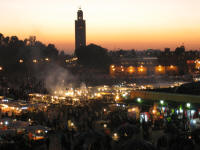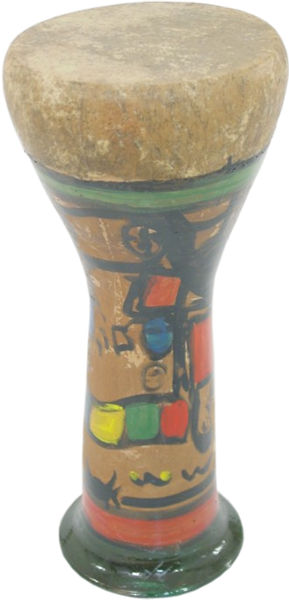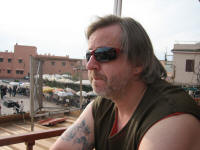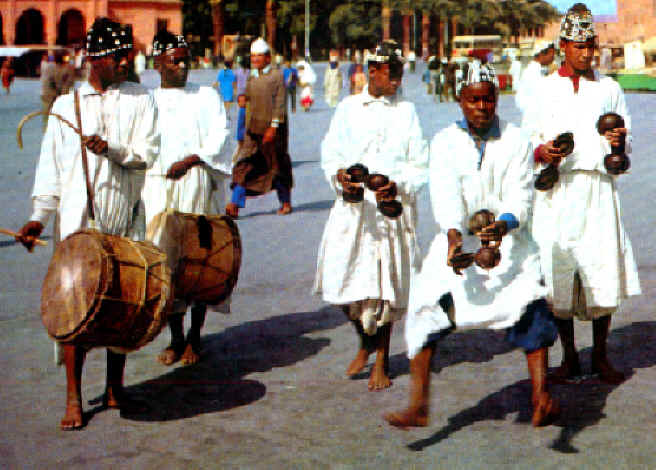|
Every percussionist I know who has been to the central
'Djemaa el-Fna'
square in Marrakech comes back highly inspired by the grooves and
drumming that is sounding out virtually 24 hours a day. The smoke
from the outdoor food stalls and the sound of distant drumming getting
nearer as you approach the lantern lit square at dusk is worth the trip
over there in its own right.

The grooves are very ambiguous and
difficult to pin down if you don't know where the beat is and so you can
sit for hours on one of the balconies around the square hearing
different divisions, placements and groupings. The basis of the
traditional 6/8 you hear with the Bendir based groups are based on the
simple fundamental rhythmic root below. This would often be heard on the
traditional Bendir drum, a frame drum aprox 14" with an internal gut
snare. Nowadays a lot of players use plastic heads and very highly
tuned drums. With this type of instrument you can really hear the
deep African roots and at times a group of Bendir players can sound like
Djembe masters from the Ivory Coast.

Basic traditional Moroccan 6/8
(Music examples are clickable to enlarge).
This would then be felt a little more like this.

The groove feels more like this


Bendir and Tarija
The groove has a couple of pivotal points which are
played on small cylindrical drums called 'Tarija'. These are
small drums similar to very tiny darabukas, longer than they are wide.
Sometimes there is a larger one (called 'Gwel') which the performer will
place over his shoulder and strike with one hand. Usually the
smaller ones are held with one hand and struck with the other. They are
usually made of clay with a thin animal hide skin. The sound is a
sharp mid tone open note. Ideally these drums should have two
parts played by two players. The parts are below.

Tarija part one

Tarija part two
Sometimes the part needs to be played by one person
and in that case both would be played on one drum with the top parts
being more of a slap/muted tone and the second part playing the open
tones. It would be like this.

Tareja parts combined
With this in mind, check out these videos recorded in
the square in 2006.
Morocco Grooves, Part 1 (Video)
Morocco Grooves, Part 2 (Video)
Morocco Grooves, Part 3 (Video)
| The ambiguities ot the feel |
The first thing one notices is how difficult it is to
identify for sure where the 'one' is. The first and most common
mistake is to hear the pulse incorrectly. For example, you could
hear the fundamental rhythmic root in 3/4 instead of 6/8, as below.

jPulse ambiguity one
Or like this.

Pulse ambiguity two
One stage worse than this is to then hear the bass
root of the rhythm in the wrong place as below. This is fundamental
rhythmic root but heard backwards.

Pulse and place ambiguity,
with the bass drum heard on the beat
This would then make the general feel of the rhythm
like this, as below.

Pulse and place ambiguity
with the bass drum heard on the beat
Then the two Tarija parts with be heard as below.

Pulse and place ambiguity,
with the tarija parts heard on the beat
There is no great crime in hearing the grooves in all
these manifestations and more. It is actually a very 'trancey'
experience and I certainly filled a whole notebook with rhythmic ideas
whilst absorbing the atmosphere.

Chilling with the groove in the square!
There are also a couple of other combinations you hear
in Marrakech. Similar grooves are played which include standard
Darabouka and 'Marrakech tambourine' which is played loosely in the
style of Arabic Req.
You also get the groups of Gnawa drummers with their
bass drums and metal castanets, equally entrancing.

Gnawa in the square!
Morocco Grooves, Part 4 (video)
Making
metal castanets (Qkraka) in Marrakech (Video)


|
